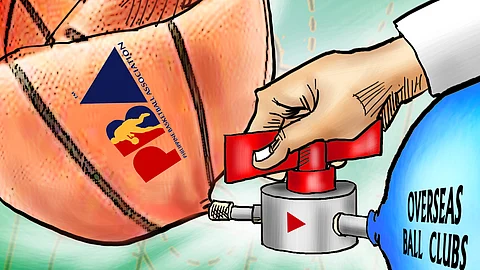
- NEWS
- the EDIT
- COMMENTARY
- BUSINESS
- LIFE
- SHOW
- ACTION
- GLOBAL GOALS
- SNAPS
- DYARYO TIRADA
- MORE

The Philippine Basketball Association’s decision to impose a three-year ban on players who choose to play overseas despite an offer from their local mother teams is a colossal step backward.
Although the intention may be rooted in the PBA’s desire to protect the domestic talent pool and maintain a competitive league, the move smacks of insecurity and a refusal to adapt to the new realities of professional basketball, where players are global commodities, whose talents are in demand in other more competitive countries where they can hone their game and better provide for their families.
The league’s rationale is simple: if we allow our best players to leave, the product will ultimately suffer. They fear the mass exodus of the marquee players will inevitably diminish the level of local on-court excitement and, by extension, the league’s market value.
Yes, as in any other business, this is a legitimate concern. But in the landscape of professional sports, it is short-sighted. Locking the gate and forcing the players to stay is not a sustainable long-term solution. It is a short-term fix that would stifle growth and breed resentment among the very assets the league is trying to protect — the players.
Let’s admit it: a professional athlete’s career has a brief lifespan. They are one major injury away from turning from hardcourt idols to wounded, forgotten heroes. That’s why every chance to play in a more competitive environment, to make a higher salary, is a golden opportunity to hone their craft and secure their future. To deny them the opportunity is killing their dreams.
The success stories of Thirdy and Kiefer Ravena, Dwight Ramos, Carl Tamayo, Kai Sotto and AJ Edu are a testament to this truth. It proves that players can still serve the country through the Gilas Pilipinas program while playing in a more competitive environment outside the PBA and providing well for their families. It’s something the new batch of stars who have left like Jamie Malonzo, Will Navarro and Arvin Tolentino can emulate.
To be fair, the PBA is trying to give the players a competitive environment. That’s the reason for opening the door to the Bay Area Dragons in 2023 and sending teams like San Miguel Beer and Meralco to the East Asia Super League.
But it isn’t enough. Have you seen June Mar Fajardo struggle for Gilas Pilipinas against seven-foot Brandon Gilbeck of Chinese Taipei or against the pesky New Zealand defenders in the 2025 FIBA Asia Cup barely a few weeks after terrorizing the paint for San Miguel Beer in the finals of the PBA Philippine Cup? What about Kevin Quimbao and Ramos — two of the best Filipino players outside the PBA — carrying the scoring load for the national squad?
The PBA needs to face reality. The solution to this “problem” is not to impose a ban, but to evolve, to come up with innovations that would encourage the players to stay. They should treat the players not as defectors but as ambassadors who represent the best of Filipino basketball.
The PBA should be a partner in a player’s journey, not an obstacle. This three-year ban will not just kill the dreams of the players, but will stand as a symbol of a league that is more interested in preserving the past than embracing the future.
